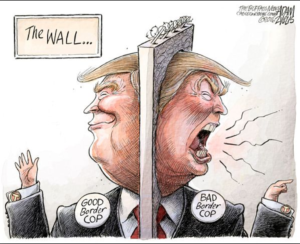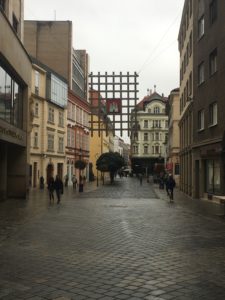How to Close Your Borders
By Cate Ferson
In the wake of the 2016 election, tensions between the Democrats and the Republicans are growing. However, the damages we are doing at home seem to be no match to those we are doing abroad. Trump’s “Mexican Wall” rhetoric has spread fear of the Hispanic population, which in the end, prevents people from taking refuge in a country where they could have a better life. The travel ban against people from Muslim-majority countries has alienated another group of people, who are attempting to escape a war-torn area. While in theory, the United States is supposed to be dissipating the fighting, we are only fueling the fire. For a nation built by immigrants who came to America to have a chance at the American Dream, we are setting a bad example to the rest of the world when in comes to allowing people to find solace in our country. Traveling around Europe, we have talked a lot about the different migrant groups that historically tried to find refuge in other countries and those who are trying to do so today. Despite the strenuous process to emigrate to the United States, we are hardly the only country that is attempting to close off its borders from the groups that we are told to fear.
In Vienna, the Nordbahnhof train station no longer exists. Bombed during World War II because it was a hub of industry, the former location of the train station is being developed for housing in a growing Vienna. Like most cities, Vienna is attracting a younger generation that is in need of work. In addition, the city is also attracting large numbers of migrants. In fact, 40% of the Viennese population has a migration background – whether it be because their parents migrated to Vienna, or they themselves migrated. This makes Vienna one of the biggest migration cities in Europe. In Austria as a whole, 15% of the population has an immigrant background, putting it just above migration rates in the United States. These numbers have made Austria a beacon state for people who are searching for a home. However, the current government is not quite interested in hosting outsiders, especially when it comes to refugees. They simply would not even recognize the refugee problem until they started to arrive in Austria in 2015 (Dirk Rupnow, University of Innsbruck). While many outsiders were able to find a home in Austria, the process of integrating them into society is long and drawn out. The largest group of migrants in Austria are the Germans. But because of Austria’s German culture, native Germans have been largely welcomed with open arms. The same cannot be said for the large populations of people from Turkey and former Yugoslavia. It seems as though the country is so afraid of protecting their own identity, which inherently is not theirs to claim. We see the same in the United States. The U.S. has lost most of its indigenous culture and its current shape is one that has been developed for centuries by people coming from all around the world.
While sitting in at the Institute of Ethnology at the Slovak Academy of Science, we looked at many aspects of Slovak life. One focus, was examining the way the Slovakian government handles the influx of migrants. Arriving in Bratislava after we had spent time in Austria, we did not have high hopes that the Slovak government would be more welcoming toward people seeking refuge there. In fact, the animosity towards migrants seemed to be much stronger. Not only does Slovak law not define the world “migrant”, it also does not use the word refugee, rather opting for “asylum seeker”. This slight change in language has a damning effect. Asylum seekers gives the implication that they may or may not be telling the truth of why they had to leave the country. Under humanitarian law, refugee status is protected. This means that you are protected once it is proven you are leaving your country because you were forced out. It is easier to turn away asylum seekers, as they may be leaving their country or origin on their own terms. Therefore, Slovakia, despite European Union sanctions, has made it extraordinarily hard for people to immigrate into the country. Typically, when walking around the capital city of a country, you would expect to see a decent amount of diversity. This was simply not the case in Bratislava.

Political cartoon of Trump smiling at Americans to try to prove that he is doing what’s best for them, while yelling at the Mexican side. (source: http://editorialcartoonists.com/cartoon/display.cfm/153890/)
The European Union and the United States are still perceived as the police of the world – meaning that it is their duty to help other countries and other citizens of the world in their time of need. More and more people are being displaced every day, and yet leaders of the free world are ignoring their cries of help.








